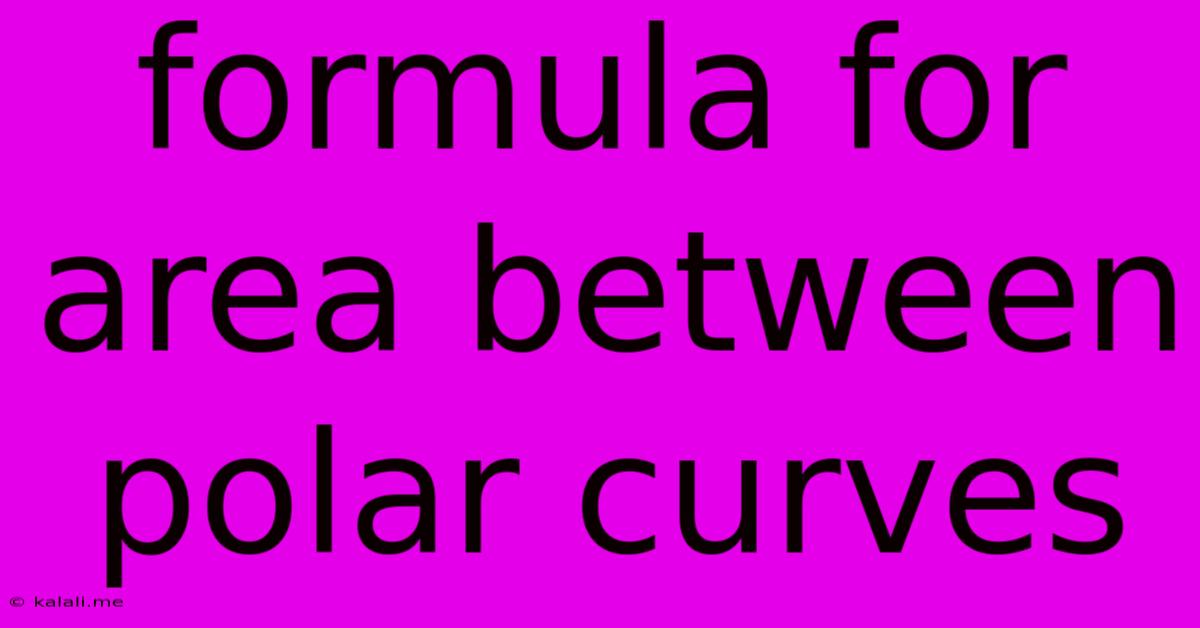Formula For Area Between Polar Curves
Kalali
Jun 03, 2025 · 3 min read

Table of Contents
Finding the Area Between Polar Curves: A Comprehensive Guide
Finding the area enclosed by polar curves is a fascinating application of calculus. Unlike Cartesian coordinates, where area is typically found using integration with respect to x or y, polar coordinates require a slightly different approach. This guide will walk you through the formula and provide practical examples to help you master this important concept in calculus. This article will cover the fundamental formula, delve into specific cases, and offer tips for tackling complex problems involving multiple curves.
Understanding Polar Coordinates
Before diving into the formula, let's refresh our understanding of polar coordinates. A point in the plane is represented by (r, θ), where r is the distance from the origin and θ is the angle measured counterclockwise from the positive x-axis. This system is particularly useful when dealing with curves that exhibit radial symmetry, such as circles, spirals, and rose curves.
The Fundamental Formula
The area A enclosed by a polar curve r = f(θ) from θ = α to θ = β is given by the integral:
A = (1/2) ∫[α, β] r² dθ
This formula stems from the fact that a small sector of the polar curve can be approximated as a triangle with area (1/2)r²dθ. Integrating over the desired range of θ sums up these infinitesimal areas to give the total area.
Case 1: Area Enclosed by a Single Curve
Let's consider a simple example. Find the area enclosed by the cardioid r = 1 + cos(θ).
To find the area, we integrate from θ = 0 to θ = 2π (a full revolution):
A = (1/2) ∫[0, 2π] (1 + cos(θ))² dθ
Expanding the integrand and using trigonometric identities, we can evaluate this integral to find the area.
Case 2: Area Between Two Curves
Finding the area between two polar curves, r₁ = f(θ) and r₂ = g(θ), where r₂ ≥ r₁ for α ≤ θ ≤ β, involves subtracting the area of the inner curve from the area of the outer curve:
A = (1/2) ∫[α, β] (r₂² - r₁²) dθ
Example: Area Between Two Curves
Let's find the area of the region that lies inside the circle r = 3sin(θ) and outside the cardioid r = 1 + sin(θ).
First, we need to find the points of intersection between the two curves by solving the equation 3sin(θ) = 1 + sin(θ). This gives us sin(θ) = 1/2, which means θ = π/6 and θ = 5π/6. The area is then given by:
A = (1/2) ∫[π/6, 5π/6] [(3sin(θ))² - (1 + sin(θ))²] dθ
Evaluating this integral will yield the area between the curves.
Tips for Solving Problems
- Sketch the curves: A sketch helps visualize the region and determine the limits of integration. It also helps in identifying which curve is the outer and inner curve when calculating the area between two curves.
- Determine the limits of integration: This often involves finding the points of intersection between the curves.
- Use trigonometric identities: These are often crucial in simplifying the integrand and making the integration process easier.
- Check your answer: Make sure your answer makes sense in the context of the problem. A negative area indicates an error in the setup or calculation.
Mastering the formula for the area between polar curves requires practice. By working through various examples, you’ll develop the skills to confidently tackle more complex problems and deepen your understanding of polar coordinates and integral calculus. Remember to always carefully sketch the curves and appropriately determine the integration limits to ensure accuracy.
Latest Posts
Latest Posts
-
Cooked Meat Left Out Overnight Covered
Jun 05, 2025
-
Why Does Reverend Mother Say Abomination
Jun 05, 2025
-
Can You Replace T12 With T8
Jun 05, 2025
-
Merge Two Images In One Pdf
Jun 05, 2025
-
Is Down An Adverb Of Manner
Jun 05, 2025
Related Post
Thank you for visiting our website which covers about Formula For Area Between Polar Curves . We hope the information provided has been useful to you. Feel free to contact us if you have any questions or need further assistance. See you next time and don't miss to bookmark.